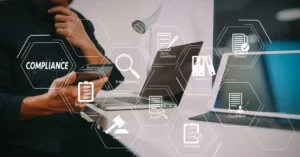Understanding the Importance of Cybersecurity for SMBs
Small and medium-sized businesses (SMBs) often think cyber-attacks are a big-company problem. But not so: cybercriminals love targeting SMBs because they tend to have weaker security defenses. This makes SMBs low-hanging fruit for attackers who aim to steal data, disrupt operations, or plant malware.
Recent reports suggest that over 43% of cyber attacks target small businesses. 60% of them who are victims of a cyber attack go out of business within six months.
Ignoring SMB cybersecurity is risky, and it’s a surefire way to put your business’s customer trust on the line, not to mention potential financial and legal repercussions. The importance of cybersecurity for SMBs can’t be overstated.
In short, robust cybersecurity isn’t a luxury—it’s a necessity for the survival and success of your business in the digital world.
Identifying Common Cyber Threats to SMBs
Small and medium-sized businesses (SMBs) face many cyber threats every day. Knowing what these threats are is the first step in defending against them.
Phishing attacks are expected. Here, scammers send fake emails pretending to be someone you trust to steal sensitive information.
Malware, short for malicious software, includes viruses and spyware that harm your system or steal data.
Ransomware is another significant threat, locking you out of your files until you pay a ransom.
Then there’s Man-in-the-middle (MitM) attacks. These happen when hackers intercept data sent between two parties, often stealing or manipulating it.
Finally, Denial-of-service attacks overload your systems, making them unusable. Each of these threats can seriously harm an SMB. Being aware is the first step to protecting your business.
The Role of SMB Cybersecurity Risk Assessment
Before diving into any cybersecurity measures, start with a cybersecurity risk assessment. It helps you understand what specific threats your business faces.
Small and medium-sized businesses (SMBs) can focus their efforts and resources on what matters most by identifying these threats. This process involves identifying valuable data, pinpointing potential threats, assessing vulnerability points, and evaluating the impact of possible cyber-attacks.
At its core, it helps you spot your weaknesses before attackers do. This means putting your money where it’s most needed rather than waiting and letting the attackers take control. With a clear understanding of your risks, deciding on the proper SMB cybersecurity measures becomes a logical and wise next step.
Essential Cybersecurity Measures Every SMB Should Implement
Every Small and Medium-sized Business (SMB) needs to take cybersecurity seriously. Without spending all the profits, there are straightforward steps to shield your business from cyber threats.
First, ensure your systems and software are always up to date. Hackers love to exploit old software vulnerabilities.
Next, educate your team on the basics of cybersecurity. Many breaches happen because someone clicked a link they shouldn’t have. Use strong passwords and consider a password manager. It’s a simple yet powerful tool against unauthorized access.
You should also regularly back up your data. If you’re hit with a ransomware attack, having your data backed up can be a lifesaver.
Finally, invest in good antivirus software and a firewall. They’re your first line of defense against many types of cyber threats. Implementing these measures doesn’t have to be costly but can save you from expensive headaches.
Developing a Cyber Incident Response Plan
A cyber incident response plan is your SMB’s game for facing cyber-attacks. Think of it like a fire drill – you hope you never need it, but you must be ready if a fire breaks out.
Start by identifying potential threats like viruses, hacking, data theft, etc.
Next, establish a response team; designate roles even if your team is small. Who’s the go-to for technical issues? Who handles communication? Then, outline clear steps to follow when a threat is detected. This includes isolating affected systems, assessing the damage, and notifying affected parties.
SMB Cybersecurity Training for Employees

Investing in cybersecurity training for your team is a smart move. Why? Because people are often the weakest link in your security chain. A small mistake, like clicking on a phishing email, can open doors for hackers.
But here’s the good news: By educating your employees on basic cybersecurity practices, you’re building a human firewall, and that’s priceless. Teach them to recognize phishing attempts, use strong passwords, and understand the importance of regular software updates.
These steps, though simple, can dramatically reduce your risk of a cyber attack. And the best part? The cost of these training sessions is minimal compared to the potential losses from a breach. So, empowering your employees with knowledge not only protects your business but does so in a cost-effective way.
Building a Solid SMB Cybersecurity Foundation
Building a solid SMB cybersecurity foundation does not have to be a daunting task. But remember, it is not a one-time project to do and forget. Hiring a professional to manage your SMB cybersecurity and protect your employees and business is vital.
Contact Link High Technologies to learn more about our IT and SMB cybersecurity services.







